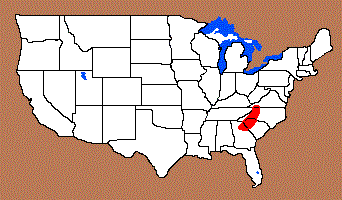Other Websites with Detailed Information:
Name Details:
Named By: Bennie C. Keel
Named For: Otarre Phase
Date Identified: 1976
Type Site: Appalachian Summit (Warren Wilson Site)
Otarre
Cluster: Iddin / Otarre Cluster
Commonly Utilized Material:
Quarts, Cherts, Quartzite, and Rhyolite
Date:
Cultural Period:
4,500 - 2,600 B.P.
Late Archaic to Early Woodland
Neoglacial
Glacial Period:
Culture:
Outline is Representative of Size and Shape:
Description of Physical Characteristics and Flaking Pattern:
This is a medium (1.5 to 2.5 inches) triangular stemmed point with an elliptical cross section. The blade may vary from straight to slightly excurvate. The shoulders may range from horizontal to having an upward angle and may be weak. The stem is straight with a base ranging from slightly concave to straight. This point has a random flaking pattern.
Size Measurements: Total Length - 29 to
70 mm (average 40 to 50 mm), Stem Length - 7 to 20 mm (average 9
to 15 mm), Blade Width - 22 to 44 mm (average 28 to 32 mm),
Stem Width at Shoulders - 13 to 23 mm (average 14 to 18 mm), Basal
Width - 13 to 22 mm (average 14 to 17 mm), Thickness - 7 to 13 mm
Distribution:
Distribution Comments:
This point is primarily found in the Blue Ridge region of Virginia, North Carolina, South Carolina and Georgia and into the Piedmont region of these areas.

Related / Associated Points:
Additional Comments:
The Otarre and Savannah River Small can be confusion. The same points shown in two different books will list differently. Ward and David (1999) shows
the Savannah River Small as a point with a slightly concave base and an Otarre as a straighter or slightly convex base (as labeled here). Bill Oliver (1999, state Archeologist for North Carolina) shows
the exact same points and has flipped the names (Otarre / Small Savannah River Stemmed). WM Hranicky shows examples in his books that does not fit into this category showing a
point with a narrow long stem with upward angled shoulders. Lloyd Schroder (2012 W18) list this point as a smaller version of the Elora point and shows examples with barbed shoulders.
Whatley (2002) states that Otarre and Swannanoa points are commonly lumped
together due to similarity in dating and morphology. Anderson and Joseph
(1988) has lumped the two together showing a plate of "Terminal Late
Archaic/ Initial Woodland" Otarre-Swannanoa points from the Rucker's Bottom
site (9EB91) in the Russell Reservoir.
Pictures:

Other points in this Cluster:
Iddin Point Validity: Valid Type
Keel is an anthropologist and
professor at the University of North Carolina – Chapel Hill. He is considered an expert on southeastern archaeology and is dedicated to archaeological preservation. He was awarded the Lifetime Achievement Award in 2012 by the Society of American Archaeology. This type was named in a professional publication and has many
professional references. This is considered a valid type.
.
Age Details:
Whatley (2002) notes: "An estimate of 4,600 to 2,600 B.P. must be proposed
since small square stemmed points appear well back in the pre-ceramic Late
Archaic period. Points of the same general typology also persist into the
Early Woodland period."
Pictures Provided By:
References: (See Reference Page, Entry Number):
23, 30, 162, W18
Otarre Projectile Point, Otarre Arrowhead



